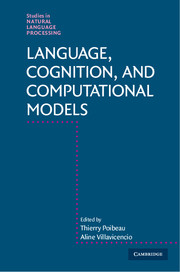Book contents
- Frontmatter
- Contents
- Figures
- Tables
- Contributors
- Part I About This Book
- Part II Models of Neural and Cognitive Processing
- Part III Data Driven Models
- Part IV Social and Language Evolution
- 9 Social Evolution of Public Languages: Between Rousseau's Eden and Hobbes’ Leviathan
- 10 Genetic Biases in Language: Computer Models and Experimental Approaches
- 11 Transparency versus Processing Efficiency: A Case Study on German Declension
- Index
- References
10 - Genetic Biases in Language: Computer Models and Experimental Approaches
from Part IV - Social and Language Evolution
Published online by Cambridge University Press: 30 November 2017
- Frontmatter
- Contents
- Figures
- Tables
- Contributors
- Part I About This Book
- Part II Models of Neural and Cognitive Processing
- Part III Data Driven Models
- Part IV Social and Language Evolution
- 9 Social Evolution of Public Languages: Between Rousseau's Eden and Hobbes’ Leviathan
- 10 Genetic Biases in Language: Computer Models and Experimental Approaches
- 11 Transparency versus Processing Efficiency: A Case Study on German Declension
- Index
- References
Summary
Abstract
Computer models of cultural evolution have shown language properties emerging on interacting agents with a brain that lacks dedicated, nativist language modules. Notably, models using Bayesian agents provide a precise specification of (extra-)liguististic factors (e.g., genetic) that shape language through iterated learning (biases on language), and demonstrate that weak biases get expressed more strongly over time (bias amplification). Other models attempt to lessen assumption on agents’ innate predispositions even more, and emphasize self-organization within agents, highlighting glossogenesis (the development of language from a nonlinguistic state). Ultimately however, one also has to recognize that biology and culture are strongly interacting, forming a coevolving system. As such, computer models show that agents might (biologically) evolve to a state predisposed to language adaptability, where (culturally) stable language features might get assimilated into the genome via Baldwinian niche construction. In summary, while many questions about language evolution remain unanswered, it is clear that it is not to be completely understood from a purely biological, cognitivist perspective. Language should be regarded as (partially) emerging on the social interactions between large populations of speakers. In this context, agent models provide a sound approach to investigate the complex dynamics of genetic biasing on language and speech.
Introduction
Biasing Language
In this chapter, we argue not only that the best approach to understanding the origins and present-day diversity of language is rooted in evolutionary theory, but also that extra-linguistic factors, more specifically biological ones in our genes, may play an important role in shaping language. Likewise, these factors do not act in a void, but interact with multiple constraints and affordances on different scales in parallel. So-called cultural evolution of language (Section 10.1.2) must thus be seen in a rich context (partially) molded by the biological and cognitive entities that ultimately acquire, use, and transmit language – us. Important factors in this context are therefore represented not only by the brain – it has been recognized for a while now that the brain indeed shapes language (Christiansen & Chater 2008) – but also by the anatomy and physiology of the vocal tract and hearing organs.
- Type
- Chapter
- Information
- Language, Cognition, and Computational Models , pp. 256 - 288Publisher: Cambridge University PressPrint publication year: 2018



